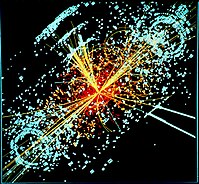
Photo from wikipedia
Temperature oscillations can affect behaviors of living things. In this article, we describe the effect of triangle temperature oscillations on reversible nonequilibrium chemical reactions detected as concentration oscillations. When amplification… Click to show full abstract
Temperature oscillations can affect behaviors of living things. In this article, we describe the effect of triangle temperature oscillations on reversible nonequilibrium chemical reactions detected as concentration oscillations. When amplification through self-catalytic reactions is involved in the chemical reactions, concentration oscillations exhibit diverse nonequilibrium phenomena, which include equilibrium intersecting, equilibrium noncontact, and equilibrium sliding. Both stable and unstable concentration oscillations occur, during which repeated cycles provide the same and different concentration oscillations, respectively. Concentration oscillations are classified according to their waveforms in concentration/time profiles, the shapes of hysteresis curves in concentration/temperature profiles, the nature of self-catalytic reactions, and their relationships with equilibrium. An unstable concentration oscillation may be transformed into a stable concentration oscillation, which is described on the basis of the classifications. Experimental examples are shown using reversible association and dissociation reactions of helicene oligomers.
Journal Title: International Journal of Molecular Sciences
Year Published: 2022
Link to full text (if available)
Share on Social Media: Sign Up to like & get
recommendations!